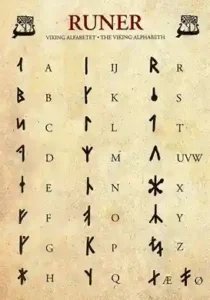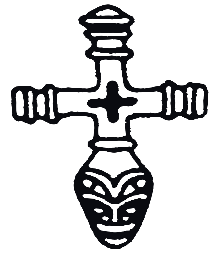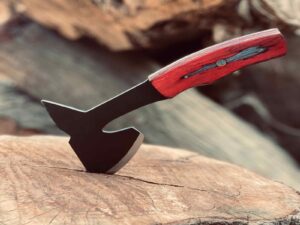
The Vikings, a fearsome and adventurous people, left behind a rich cultural heritage that continues to fascinate and inspire. One of the most intriguing aspects of Viking culture is their use of symbols deeply embedded in their beliefs, traditions, and daily life. This article explores some of the most prominent Nordic symbols used by the Vikings, providing insights into their meaning and significance.
Most Prominent Nordic Symbols List:
1- Þors Hammer (Thor’s Hammer) – Mjölnir
- Symbolism: Mjölnir, the hammer of Thor, the god of thunder, is one of the most iconic symbols from Viking Age Norse culture. It represents protection, blessings, and power.
- Usage: Thor’s Hammer was commonly worn as an amulet around the neck. It was believed to offer protection from evil forces and ensure fertility and prosperity. During Viking times, Mjölnir was also used in rituals, including marriages and blessings.
- Design: The hammer is often depicted as a short-handled hammer with a square head. Artistic representations vary, but they usually maintain a robust and simplistic appearance.
2- Valknut

- Symbolism: The Valknut is a symbol consisting of three interlocked triangles. It is associated with Odin, the chief of the Aesir gods, and symbolizes the transition between life and death, the afterlife, and the binding of the soul.
- Usage: The Valknut frequently appears on runestones, grave markers, and weapons like axes. It was believed to be a protective symbol for those who had passed away and was often associated with warriors and the afterlife.
- Design: The design of the Valknut is characterized by its three interlocked triangles, forming a geometric and intricate pattern that creates a sense of interconnection and eternity.
3- Yggdrasil

- Symbolism: Yggdrasil is the world tree, an enormous and central ash tree in Norse cosmology that connects the nine worlds. It represents the structure of the cosmos and the interconnectedness of all life.
- Usage: Yggdrasil symbolized the foundation of the universe and was important in various mythological tales. It also appeared in Viking art and carvings, reflecting the centrality of nature and cosmic order in Norse belief.
- Design: Typically depicted as a massive tree with sprawling branches and roots, often illustrated with various mythical creatures and worlds hanging from it.
4- Runes

- Symbolism: Runes are the characters of the runic alphabet, used both for writing and magical purposes. Each rune has its meaning and symbolism, related to various aspects of life and the cosmos.
- Usage: Runes were used for inscriptions on stones, weapons, and artifacts, and they were believed to hold magical powers. They were also used for divination, spells, and invoking protection or blessings.
- Design: The runic alphabet, or Futhark, consists of angular characters. The Elder Futhark, used from the 2nd to the 8th century, includes 24 runes, while the Younger Futhark, used from the 9th century onward, has 16 runes.
5- Huginn and Muninn

- Symbolism: Huginn and Muninn are Odin’s ravens, representing thought (Huginn) and memory (Muninn). They symbolize Odin’s quest for knowledge and his role as a seeker of wisdom.
- Usage: These ravens are frequently depicted in Viking art and are symbolic of Odin’s power and insight. They were often used in iconography to signify wisdom and the god’s omnipresence.
- Design: The ravens are often shown in flight or perched, sometimes with a stylized, intricate design that reflects their mystical nature.
6- Aegishjalmur (Helm of Awe)

- Symbolism: The Aegishjalmur, or Helm of Awe, is a powerful protective symbol meant to confer fearlessness and invulnerability in battle.
- Usage: This symbol was used in magical and ritualistic contexts, believed to protect the wearer and instill terror in enemies. It is often found on runestones, artifacts, and weapons such as axes.
- Design: The Aegishjalmur consists of eight symmetrical, spiked arms radiating from a central point, forming a star-like pattern that is both striking and formidable.
7- Jörmungandr (Midgard Serpent)

- Symbolism: Jörmungandr, the Midgard Serpent, encircles the world and represents chaos and the cyclical nature of existence. Its presence signifies the balance between order and chaos.
- Usage: The serpent is often depicted in Viking art, and its symbolism was associated with the cyclical nature of life and the impending Ragnarok, the end of the world in Norse mythology.
- Design: The Midgard Serpent is typically depicted as a massive, coiled serpent, sometimes biting its own tail, illustrating the concept of eternal recurrence.
8- Sun Cross (Solkors)
- Symbolism: The Sun Cross, or Solkors, symbolizes the sun and its life-giving power. It represents the cycle of the seasons and the importance of the sun in Norse mythology.
- Usage: This symbol was used in art and possibly in rituals related to the sun and the changing seasons. It underscores the importance of the solar cycle in agricultural and daily life.
- Design: The Sun Cross usually features a circle with a cross inside it, representing the sun and its four cardinal directions.
9- The Wolf Cross

- Symbolism: The Wolf Cross often represents a fusion of Christian and pagan symbolism. The wolf represents strength, ferocity, and connection to nature, while the cross can symbolize the World Tree, Yggdrasil.
- Design: The design of the Wolf Cross typically features a cross embellished with wolf imagery. This can include stylized wolf heads or paws integrated into the cross’s arms or surrounding it. The cross itself may vary in style, from ornate and intricate to simple and stark, depending on its intended use and cultural context.
- Usage: The Wolf Cross is used in various contexts, including religious and cultural artifacts, jewelry, and art. In some communities, it serves as a personal or communal symbol of faith combined with local traditions.
10- The Spiral

- Symbolism: The spiral often represents growth, evolution, and the cyclical nature of life. In many cultures, spirals are seen as a symbol of infinity and the perpetual motion of the universe, reflecting the idea that life is an ongoing cycle of birth, growth, death, and rebirth.
- Design: Designs featuring spirals can vary widely, from simple, elegant curves to complex, intricate patterns. The most common spiral designs include the logarithmic spiral, which appears in nature (like shells and galaxies), and the Fibonacci spiral, which is associated with mathematical sequences and natural growth patterns.
- Usage: Spirals are used in numerous contexts. In art and design, they often serve as decorative elements that add fluidity and balance to compositions. In architecture, spirals can be found in staircases and structural details, symbolizing ascent and connection between different levels. Spirals also appear in spiritual and ritual contexts, where they are used to represent spiritual journeys or meditative practices.
Conclusion
Nordic symbols from the Viking Age are a rich tapestry of cultural and spiritual significance. Each symbol carried deep meanings related to protection, power, knowledge, and the natural world. These symbols not only served practical purposes in daily Viking life but also played a crucial role in their spiritual and mythological beliefs. Understanding these symbols provides valuable insights into the values and worldview of the Vikings and their complex cosmology.







